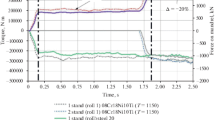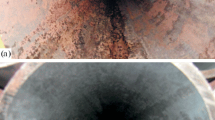Abstract
Pipe rolling units (PRU) with three-high screw rolling mills are used to produce hot-rolled seamless pipes. Two units with rolling mills are operated in Russia: one is the TPA-160 mill at Pervouralsk Novotrubny Plant, JSC (Pervouralsk, Sverdlovsk oblast, Russia) and the second is the TPA-200 mill at Volzhsky Pipe Plant, JSC (Volzhsky, Volgograd oblast, Russia). Currently, increasing the technological capabilities of these PRUs is one major problem. It is necessary to expand the size and grade range, as well as utilize a non-traditional application of the sizing and rolling mills for screw rolling. To resolve these problems, the processes of reducing or plugless rolling of pipes on three-high screw rolling mills with increased reduction in diameter up to 25% are studied. The results of computer finite element simulation using QForm software are presented. The objective is to study the effect of the rolling process with increased diameter reductions on metal forming in the deformation zone and on changes of geometrical dimensions when reducing the capped blanks with different wall thickness on experimental-industrial mills. The capped blank ovality is quite important during metal forming when screw rolling. The ovality is the ratio of the feed radius when the metal comes in contact with the roll and the radius under the roll in the deformation zone cross section. The ovality characterizes the resistance of capped blank to deformations in inter-roll space. Reducing the thin-wall capped blanks is accompanied by large values of ovality, which makes the deformation process less stable. Therefore, the formation of shape defects (faceting) and end defects is possible during the plug rolling process. The rolling process ovality on the plug increases more intensely as compared with plugless rolling. The presence of plug limits the metal displacement in the axial direction and promotes metal displacement in the gaps between rolls. During plug rolling, it is necessary to use the rolls with shoulder, which make it possible to carry out the main reduction in the wall, thereby localizing the reduction zone on the plug and then decreasing the ovality of capped blanks.




Similar content being viewed by others
REFERENCES
Romantsev, B.A., Goncharuk, A.V., Vavilkin, N.M., and Samusev, S.V., Trubnoe proizvodstvo. Uchebnik (Pipe Production: Manual), Moscow: Mosk. Inst. Stali Splavov, 2011.
Kolikov, A.P. and Romantsev, B.A., Teoriya obrabotki metallov davleniem. Uchebnik (Theory of Metal Forming: Manual), Moscow: Mosk. Inst. Stali Splavov, 2015.
Romanenko, V.P., Stepanov, P.P., Goncharuk, A.V., Kriskovich, S.M., Illarionov, G.P., Nikulin, A.N., and Filippov, G.A., Advanced technology for production of hollow car axles from a hollow billet, Probl. Chern. Metall. Materialoved., 2016, no. 2, pp. 27–34.
Shevakin, Yu.F., Kolikov, A.P., Romanenko, V.P., and Samusev, S.V., Mashiny i agregaty dlya proizvodstva stal’nykh trub: uchebnoe posobie dlya vuzov (Machines and Units for Production of Steel Pipes: Manual for Higher Education Institutions), Shevakin, Yu.F., Ed., Moscow: Intermet Inzhiniring, 2007.
Shamanaev, V.I., Study of the process of helical rolling of thick-wall cupped blanks and pipes, Extended Abstract of Cand. Sci. (Eng.) Dissertation, Moscow: Moscow Inst. Steels Alloys, 1979.
Yamada, T., US Patent 4409810, 1983.
Muller, G., US Patent 3495429, 1966.
Jiang, Y. and Tang, H., Method for improving transverse wall thickness precision of seamless steel tube based on tube rotation, J. Iron Steel Res. Int., 2015, vol. 22, no. 10, pp. 924–930.
Kharitonov, E.A., Romanenko, V.P., and Budnikov, A.S., Sleeve deformation in a three-roller screw-rolling mill, Steel Transl., 2016, vol. 46, no. 3, pp. 180–185.
Romancev, B.A., Goncharuk, A.V., Aleshchenko, A.S., and Gamin, Yu.V., Production of hollow thick-walled profiles and pipes made of titanium alloys by screw rolling, Russ. J. Non-Ferrous Met., 2015, vol. 56, no. 5, pp. 522–526.
Romanenko, V.P., Man’ko, A.I., Stepanov, P.P., Perminova, O.N., and Kriskovich, S.M., Advanced technology for producing hollow car axles based on screw conversion, Aktual’nye Probl. Mashinostr., 2017, vol. 4, no. 2, pp. 28–34.
Galkin, S.P., Fadeev, V.A., and Gusak, A.Yu., Comparative analysis of geometry of mini-mills of radial shear (screw) rolling, Proizvod. Prokata, 2015, no. 12, pp. 19–25.
Galkin, S.P., Index of lateral deformation at conversion in screw rolling mill, Proizvod. Prokata, 2011, no. 9, pp. 18–23.
Nikulin, A.N., Vintovaya prokatka. Napryazheniya i deformatsii (Screw Rolling. Stresses and Deformations), Moscow: Metallurgizdat, 2015.
Pan, K., Wang, X., and Qing, G., Finite element simulation of tube stretch-reducing wall thickness cross-section with round passes system, J. Univ. Sci. Technol. Beijing, 2000, vol. 22, no. 1, pp. 38–40.
Karpov, B.V., Skripalenko, M.M., Galkin, S.P, Skripalenko, M.N., Samusev, S.V., Huy, T.B., and Pavlov, S.A., Studying the nonstationary stages of screw rolling of billets with profiled ends, Metallurgist, 2017, vol. 61, nos. 3–4, pp. 257–264.
Joun, M.-S., Lee, J., Cho, J.-M., Jeong, S.-W., and Moon, H.-K., Quantitative study on Mannesmann effect in roll piercing of hollow shaft, Procedia Eng., 2014, vol. 81, pp. 197–202.
Wang, F.-J., Shuang, Y.-H., Hu, J.-H., Wang, Q.-H., and Sun, J.-C., Explorative study of tandem skew rolling process for producing seamless steel tubes, J. Mater. Process. Technol., 2014, vol. 214, no. 8, pp. 1597–1604.
Naizabekov, A.B., Lezhnev, S.N., Dyja, H., Bajor, T., Tsay, K., Arbuz, A., Gusseynov, N., and Nemkaeva, R., The effect of cross rolling on the microstructure of ferrous and non-ferrous metals and alloys, Metallurgija, 2017, vol. 56, nos. 1–2, pp. 199–202.
Budnikov, A.S., Kharitonov, E.A., and Sorokin, F.V., Study of pipe wall thickness variations in process of reduction on three-high screw rolling mill, Stal’, 2017, no. 10, pp. 31–34.
ACKNOWLEDGMENTS
R.V. Iskhakov and A.R. Shamilov (Pervouralsky Novotrubny Zavod JSC).
Author information
Authors and Affiliations
Corresponding authors
Additional information
Translated by M. Kromin
About this article
Cite this article
Aleshchenko, A.S., Budnikov, A.S. & Kharitonov, E.A. Metal Forming Study during Pipe Reduction on Three-High Rolling Mills. Steel Transl. 49, 661–666 (2019). https://doi.org/10.3103/S0967091219100024
Received:
Revised:
Accepted:
Published:
Issue Date:
DOI: https://doi.org/10.3103/S0967091219100024




